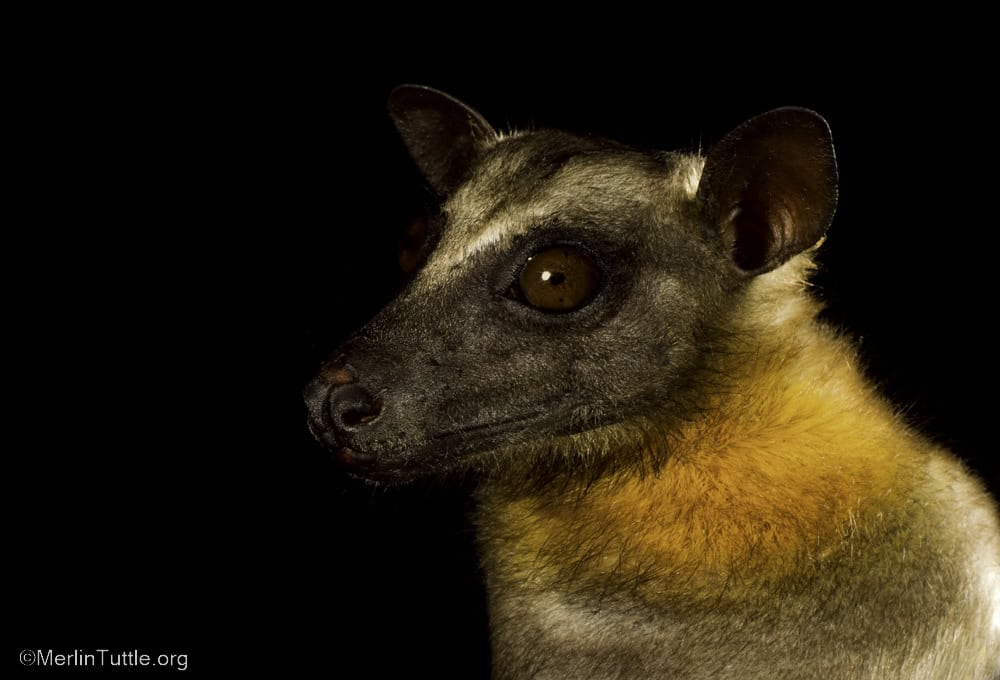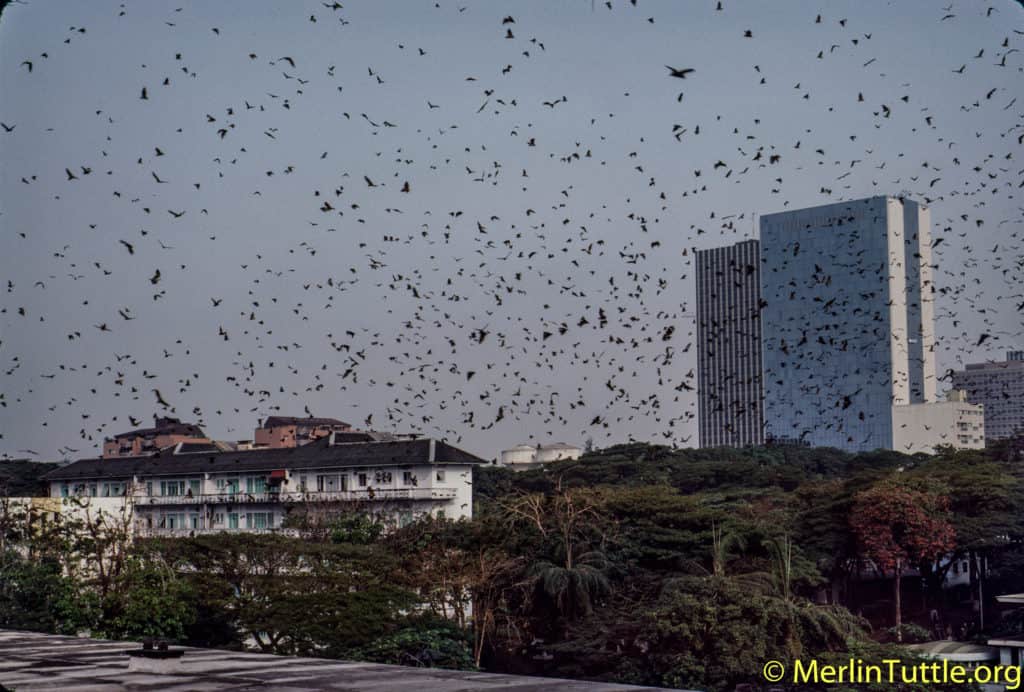Bat Flash: Countering Misinformation and Championing Evidence-Based Science
On March 6, 2024, the Wall Street Journal presented findings from the University of Leeds in their opinion piece, “Why Scientists Love Chasing Bats; The
I share Benoit Nyemba and Fiston Mahamba’s concern regarding a potential resurgence of Ebola in the Democratic Republic of Congo, as Reuters News reported on May 8. Nevertheless, continuing to blame bats as the source is likely to reverse conservation progress essential to ecosystem health (Lopez-Baucells et al. 2018) and delay successful Ebola prevention. Understanding the true source is essential.
Bats can indeed transmit deadly diseases like rabies and Nipah to humans, though transmission is exceedingly rare and easily avoided. In the case of Ebola, bats have been too easily assumed guilty. A wide variety have been tested at outbreak locations. But, “Ebolavirus has yet to be isolated from bats, and no direct evidence links bats to Ebolavirus infection in humans.” (Spengler et al. 2016) Virologists still know “nothing about where it comes from and how it causes outbreaks.” (Kupferschmidt 2017).

Early Ebola outbreaks were traced to human consumption of infected chimpanzees, gorillas and duikers (Rouquet et al. 2005), though these animals were believed to be too susceptible to serve as reservoirs (Wittmann et al. 2007).
Nevertheless, subsequent research revealed Ebola antibodies in 10 percent of gorillas (Reed et al. 2014) and in 18.7 percent of pygmies (Mulangu et al. 2016), demonstrating that exposure is not as uniformly lethal in either great apes or humans as previously believed. Nancy Sullivan, a viral immunologist with the Vaccine Research Center at the National Institutes of Health, notes that “there is little evidentiary data to document widespread death of apes from Ebola” (Pedris 2017). These discoveries provide potential breakthroughs in the hunt for reservoirs.
The preponderance of evidence now points to sources other than bats (Leendertz 2016). There are four African species of Ebola: Sudan, Zaire, Bundibugyo, and Tai Forest Ebola. The geographical distributions are along separate river basins, and this is inconsistent with a highly mobile source, such as bats. Bats easily cross river basins. Experimentally infected bats can survive infection, as often cited, but they also show no evidence of viral shedding and are unlikely transmitters (Paweska et al. 2016).
Current claims that bats are the most likely sources of Ebola appear to have gained momentum from careless reporting of the index case for the 2013-2014 outbreak. The first team to investigate speculated a fruit bat origin, despite a complete lack of supporting evidence, as noted by a second team who also found no evidence of Ebola in a large sample of both fruit and insect-eating bats, but still speculated an insect-eating bat origin, whereupon the roost was burned with the bats inside (Saez et al. 2015).
It now seems likely that the disproportionate epidemiological focus on bats may have delayed much needed progress (Tuttle 2017) while doing great harm to the conservation of bats (Lopez-Baucells et al. 2018). Bats are economically and ecologically invaluable, but they also rank among our planet’s most endangered wildlife (Voigt and Kingston 2015). It’s time to halt the bias. People don’t tolerate animals they fear, and we need to know where Ebola is coming from.
Our combined voices can make a difference. Choose any or all means of contact to reach out to the staff at Reuters News and politely share your opinion in your own words. Editors do take notice. Remember, your response can be very simple such as, “I don’t appreciate premature speculation that creates needless fear of bats.” Editors just need to know you like or dislike an article in order for you to have impact. It’s numbers that count. Bats need all of you!

References
Kupferschmidt, K. 2017. Hunting for Ebola among the bats of the Congo. Science, June 1.
Leendertz, S.A.J. 2016. Testing new hypotheses regarding ebolavirus reservoirs. Viruses 8(2), 30; doi:10. 3390/v8020030.
Lopez-Baucells, A., Rocha, R. and A. Fernandez-Llamazares. 2018. When bats go viral: negative framings in virological research imperil bat conservation. Mammal Review 48(1): 62-66.
Mulangu, S., M. Borchert, J. Paweska, A. Tshomba, A. Afounde, A Kulidri, R. Swanepoel, J.J. Muyembe-Tamfum, and P. Van der Stuyft. 2016. High prevalence of IgG antibodies to Ebola virus in the Efe pygmy population in the Watsa region, Democratic Republic of the Congo. BMC Infec. Dis. June 10;16;263
Paweska, J.T., N. Storm, A.A. Grobbelaar, W. Markotter, A. Kemp, and P.J. van Vuren. 2016. Experimental inoculation of Egyptian fruit bats (Rousettus aegyptiacus) with Ebola virus. Viruses 8(2):29.
Pedris, L. 2017. Going viral: How advancements in Ebola disease detection in wild apes can help to prevent dangerous outbreaks. Mongabay, May 4.
Reed, P.E., S Mulangu, K.N. Cameron, A.U. Ondzie, D. Joly, M. Bermejo, P. Rouquet, G. Fabozzi, M. Bailey, Z. Shen, B.F. Kele, B. Hahn, W.B. Karesh, and N.J. Sullivan. 2014. A new approach for monitoring Ebolavirus in wild great apes. PLOS, Sept. 18, https://doi.org/10.1371/journal.pntd.0003143.
Rouquet, P. J-M. Froment, M. Bermejo, A. Kilbourn, W. Karesh, P. Reed, B. Kumulunqui, P. Yaba, A. Delicat, P.E. Rollin, and E.M. Leroy. 2005. Wild animal mortality monitoring in human Ebola outbreaks, Gabon and Republic of Congo, 2001-2003. Emerg. Infect. Dis. 11(2):283-290.
Saez, A.M., S. Weiss, K. Nowak, V. Lapeyre, F. Zimmermann, A. Dux, H.S. Kuhl, M. Kaba, S. Regnaut, K. Merkel, A. Sachse, U. Theisen, L. Villanyi, C. Boesch, P.W. Dabrowski, A. Radonic, A. Nitsche, S.A. J. Leendertz, S. Petterson, S. Becker, V. Krahling, E.Couacy-Hymann, C. Akoua-Koffi, N. Weber, L. Schaade, J. Fahr, M. Borchert, J.F. Gogarten, S. Calvignac-Spencer, and F.A. Leendertz. 2015. Investigating the zoonotic origin of the West African Ebola epidemic.
Tuttle, M.D. 2017. Give bats a break. Issues in Science and Technology. Spring edition.
Voigt, C.C. and T. Kingston (eds). 2016. Bats in the Anthropocene: Conservation of bats in a changing world. DOI 10,1007/978-3-319-25220-9_1.
Love our content? Support us by sharing it!
On March 6, 2024, the Wall Street Journal presented findings from the University of Leeds in their opinion piece, “Why Scientists Love Chasing Bats; The
Response to Misleading Scientific American Bat Story I am responding to the article titled, “A Secret Weapon in Preventing the Next Pandemic: Fruit Bats,” which
Believe it or not, bats have one of our planet’s finest records of living safely with humans. Despite frequent claims to the contrary, they harbor
The series Curious Kids, hosted by The Conversation, is designed to provide expert answers to questions asked by children from around the world. The December
2024 © Merlin Tuttle’s Bat Conservation. All rights reserved.
Madelline Mathis has a degree in environmental studies from Rollins College and a passion for wildlife conservation. She is an outstanding nature photographer who has worked extensively with Merlin and other MTBC staff studying and photographing bats in Mozambique, Cuba, Costa Rica, and Texas. Following college graduation, she was employed as an environmental specialist for the Florida Department of Environmental Protection. She subsequently founded the Florida chapter of the International DarkSky Association and currently serves on the board of DarkSky Texas. She also serves on the board of Houston Wilderness and was appointed to the Austin Water Resource Community Planning Task Force.
Michael Lazari Karapetian has over twenty years of investment management experience. He has a degree in business management, is a certified NBA agent, and gained early experience as a money manager for the Bank of America where he established model portfolios for high-net-worth clients. In 2003 he founded Lazari Capital Management, Inc. and Lazari Asset Management, Inc. He is President and CIO of both and manages over a half a billion in assets. In his personal time he champions philanthropic causes. He serves on the board of Moravian College and has a strong affinity for wildlife, both funding and volunteering on behalf of endangered species.